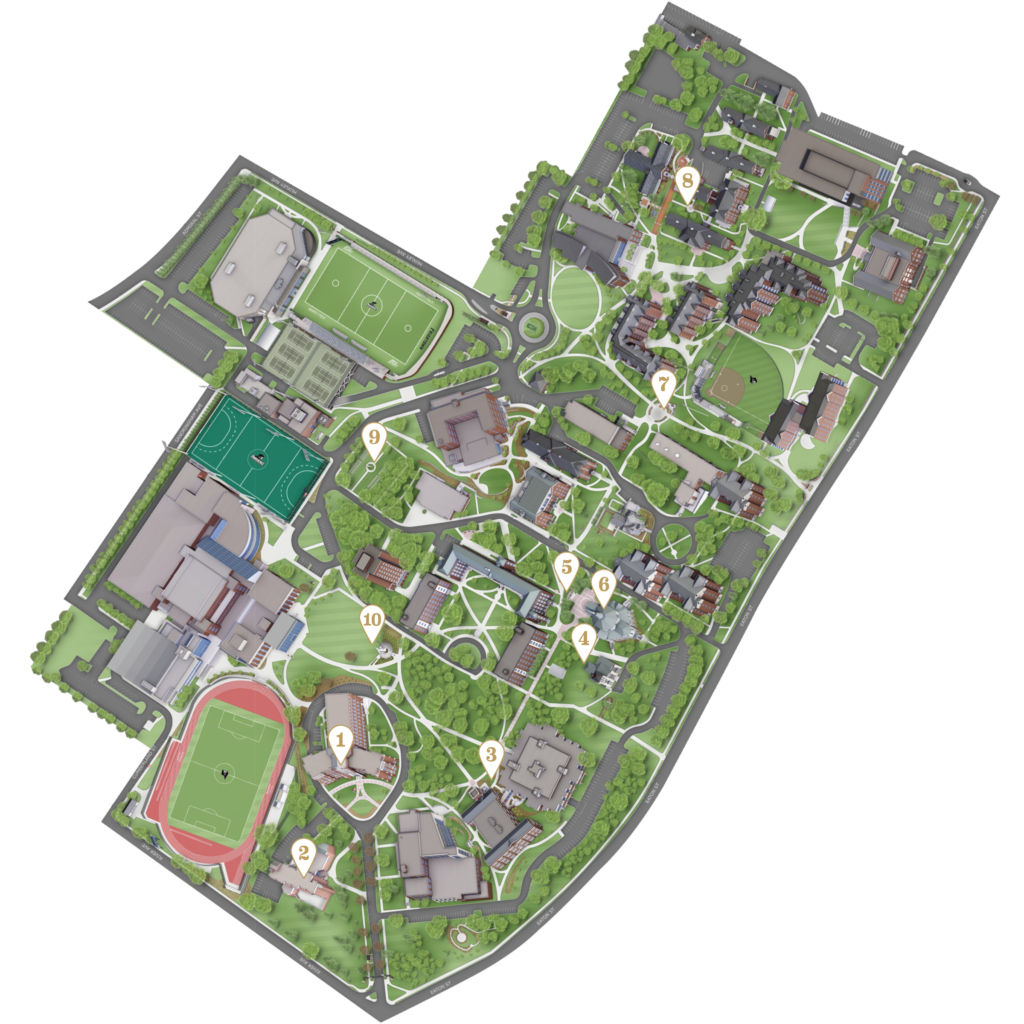A Campus Pilgrimage
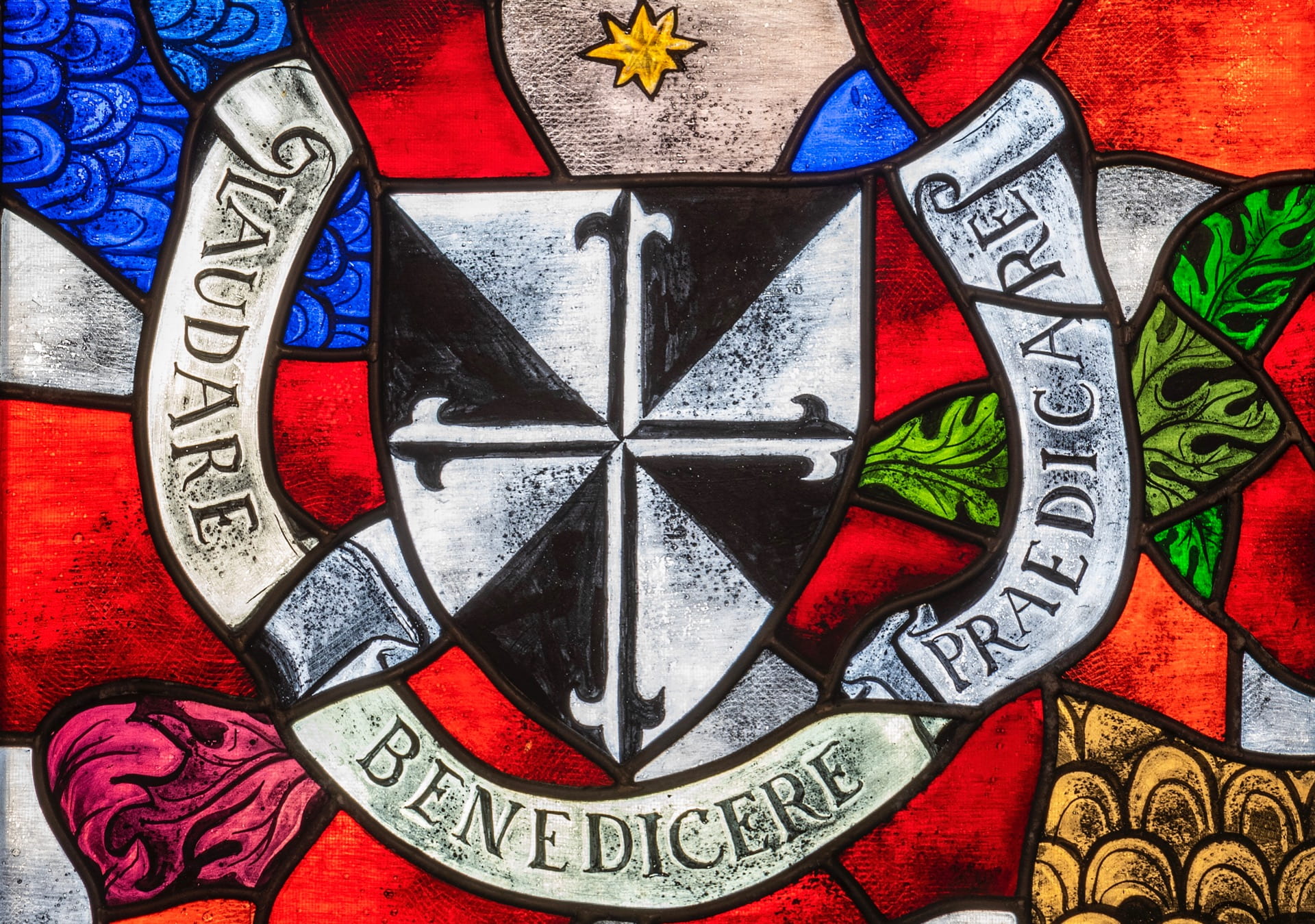
A Campus Pilgrimage
Sacred Spaces at Providence College
A tour of sacred spaces at Providence College is offered to our more than 57,000 graduates with gratitude for your loyalty, support, and friendship. Hopefully, as you view a “stop” on this spiritual journey you will have happy and holy memories of the women and men who were with you during your years at the College and offer a prayer in thanksgiving for them. The sacred spaces on campus all speak to the mission of Providence College. They remind us of God’s constant care and goodness for each and every one.
Rev. James F. Quigley, O.P. ’60
Associate Alumni Chaplain
1. Harkins Hall
About
To change this label, please fill in the field “Tab Label” on the right.

Bishop Matthew Harkins invited the Dominican friars from the Province of St. Joseph to come to Rhode Island to establish a college. Harkins Hall, named in honor of the bishop, was dedicated May 25, 1919, and Providence College opened with 71 students and nine Dominican friar faculty members. Harkins Hall is the recognizable image of Providence College since 1919. It is a curved, neo-Gothic structure. As Dr. Joan Branham of the Department of Art and Art History points out, its prominent arches and vaulted ceilings contribute to a sense of harmony and beauty. Statues of Mary, Saints Albert the Great, Thomas Aquinas, Catherine of Siena, and Saint Dominic are prominent on the façade. Nuanced architectural designs point to the Dominican identity of the College.
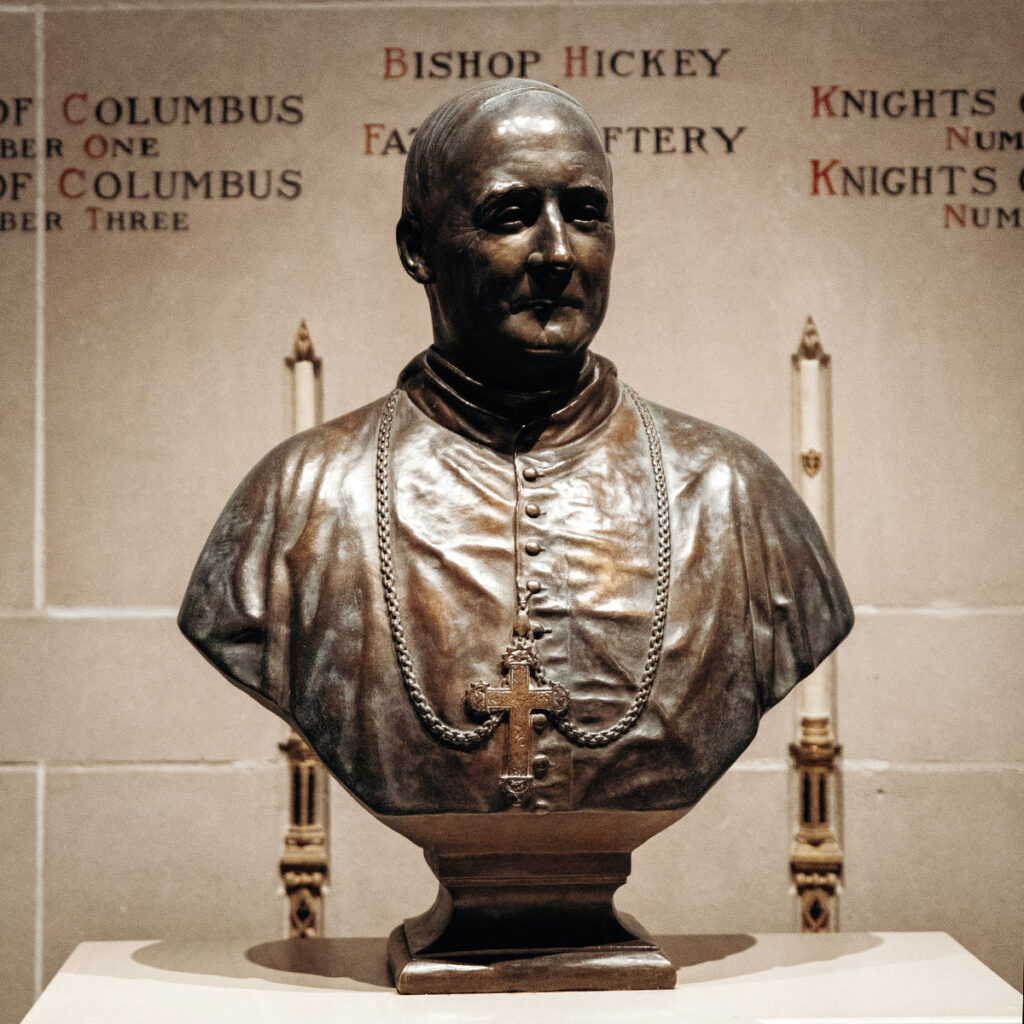
Harkins Hall in early years housed the campus library, a gym, St. Pius parish church, classrooms, laboratories, offices, and a home for friars on the fourth and fifth floors. Today it is the administrative center for the College with some classrooms and meeting rooms.
Reflection
To change this label, please fill in the field “Tab Label” on the right.

Gothic harmony joins various elements and points them beyond to a further reality. The architecture of Harkins Hall and the statues on the façade graphically demonstrate the educational vision of the Dominican Order. Reason, science, theology, spirituality, and faith are the mission of the institution. The Madonna with arms outstretched welcomes those seeking that vision for life. Mary, the mother of Christ, is the mother of the Providence College community. She intercedes for all who study, teach, promote, assist, and serve at the College. Albertus Magnus, also known as Albert the Great, patron saint for scientists, Thomas Aquinas for Catholic education, Catherine of Siena, the great spiritual writer and mystic; and Dominic the founder of the Order of Preachers. These saints watch over all who come to Providence College to learn, teach, promote, and share truth.
Prayer
To change this label, please fill in the field “Tab Label” on the right.
Mary, Our Lady of Providence, pray for the community gathered here in this College that they may grow in wisdom, intellect, virtue and faith in God, Father, Son, Holy Spirit. Pray that your son, the Lord Jesus Christ, empower them with the desire, ability, and confidence to work for a just, peaceful, loving world. Help them always to be grateful for the integral, humanistic, moral education they receive here. Show them how to be examples to others with humility and perseverance. Bless them, their families, alumni, alumnae, donors. Amen.
2. St. Thomas Aquinas Priory Gragnani Dominican Center
About
To change this label, please fill in the field “Tab Label” on the right.
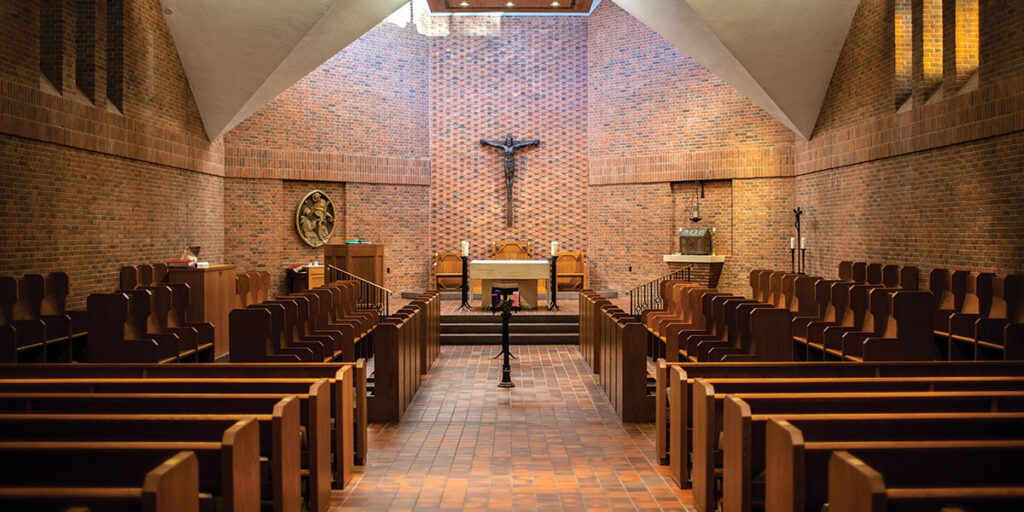
Dominican friars lived for many years on the fourth floor of Harkins Hall. As the number of friars grew, some lived in residence halls. In 1984, the community moved to the priory, although a small number continue to live in residence halls. In the priory, the friars live, study, and minister to students and faculty. There they pray in Our Lady of Rosary chapel. Each day the friars meet to offer the official morning and evening prayer of the Church, the Divine Office that all priests promise at ordination to pray daily for God’s people. Eucharist is offered every morning, and some laity regularly attend.
Reflection
To change this label, please fill in the field “Tab Label” on the right.
The Order of Preachers, Dominicans, was officially confirmed by the Pope in the year 1216. It spread quickly throughout Europe. A few centuries later, in the year 1805, a young man from Maryland, Edward Dominic Fenwick, brought the Dominicans to the United States and the Province of St. Joseph was established. The friars at first were missionaries on the frontier and the far West as the United States expanded. With the arrival of large numbers of immigrants from Ireland, Germany, Italy, Poland, and Eastern Europe, the Dominicans moved their ministry to the Northeast. In 1905 a seminary, or house of studies to educate future Dominicans, was begun in Washington, D.C. and in 1917 Providence College began its mission to serve the children of newly arrived immigrants.
Today the friars from the Province of St. Joseph serve in campus ministries at Brown University, New York University, Johns Hopkins University, the University of Virginia, and the University of Louisville. They staff parishes in Springfield, Kentucky, New York City, Philadelphia, Washington, D.C., Columbus, Ohio, and Rockville Centre, New York. Some Friars are preachers offering retreats to priests, women religious, and laity. Others serve overseas as professors at the University of St. Thomas Aquinas in Rome. Friars also serve in Kenya, East Africa.
St. Thomas Aquinas Priory at Providence College opened in 1984. It was made possible through the very generous gifts of Frank ’40 and Charlotte Grangnani, who also contributed to St. Dominic Chapel. Frank Gragnani was an alumnus who always appreciated what Dominicans and the College gave him. The priory houses some 30 friars, who live, work, study, pray, and teach.
Prayer
To change this label, please fill in the field “Tab Label” on the right.
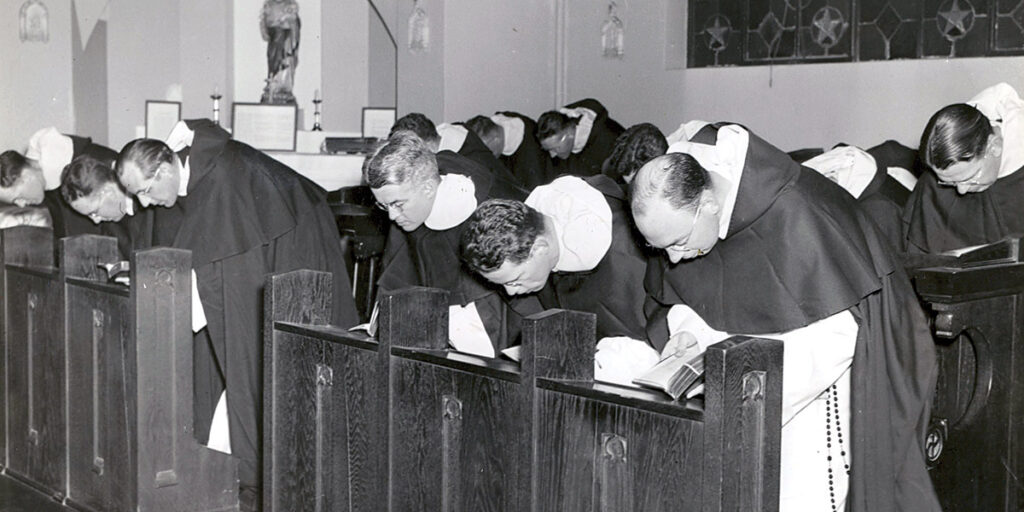
Remember, O most gracious virgin Mary, that never was it known that anyone who came to you, asked your help, or sought your intercession was left unaided. Inspired by this confidence we come to you, Our Lady of the Rosary, and faithful mother. Please hear our prayers which we offer with hope and humility. Amen.
3. St. Thomas Aquinas Statue
About
To change this label, please fill in the field “Tab Label” on the right.
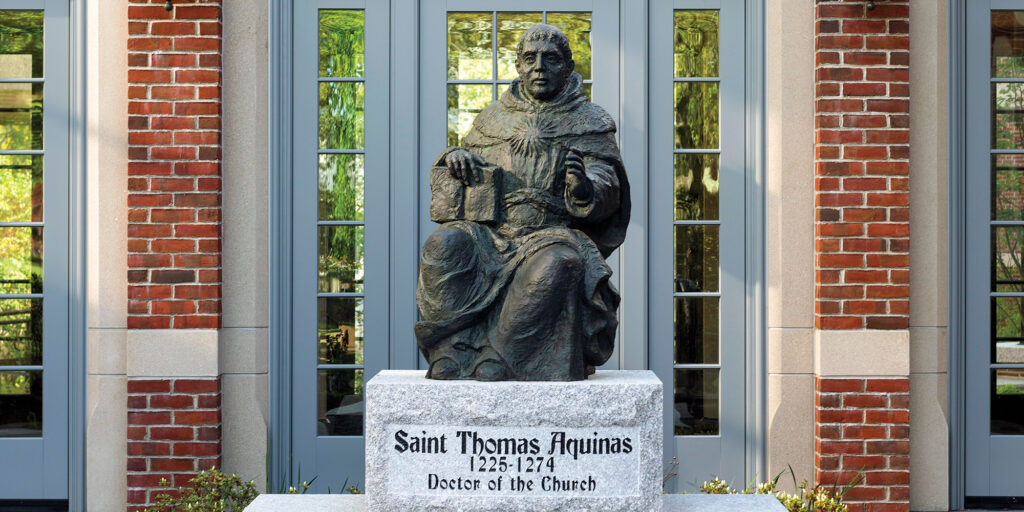
Thomas Aquinas is a significant presence on the Providence College campus. The first residence hall built was Aquinas Hall, in 1938. The Dominican priory is named after him — St. Thomas Aquinas Priory–Grangnani Dominican Center. A new, marvelous statue of the saint is now in a garden next to the Ruane Center for the Humanities. The statue was sculpted by Sylvia Nicolas ’01Hon., the artist who designed the stained glass windows in St. Dominic chapel. The College’s attention to Aquinas is an important facet of Dominican identity. Friars have been schooled in the theological and philosophical thought of St. Thomas for centuries. Aquinas’ teachings form a significant part of the Dominican intellectual tradition, a tradition that uniquely describes the Catholic identity of the College.
Reflection
To change this label, please fill in the field “Tab Label” on the right.
Saint Thomas entered the newly founded Dominican Order over the protests of his family. Rather than the security of monastic life in Monte Cassino in the south of Italy he opted for the exciting movement of a community dedicated to preaching the gospel in a time of new cities, new economies, new universities, and new pastoral needs. Aquinas’ genius reshaped Catholic thinking. His pastoral-theological project is contained in some 60 known written works which spanned a wide spectrum of topics, including commentaries on biblical books, the writings for Aristotle, and a variety of catechetical and theological subjects. Perhaps his most recognized work is the Summa Theologica, which he composed to train young Dominicans for the task of preaching and hearing confessions.
Thomas Aquinas was a courageous, humble intellectual who listened and learned from others, even those he disagreed with. He struggled with the great mysteries of the Christian faith and the complexities of human experience and sought the truth and then tried to share that with others. His sensitivity to the mystery of God can be seen in the care he took in expressing his thoughts. It is also obvious in his poetry as seen in the hymns dedicated to Jesus Christ, present in the eucharist.
At the end of his productive life as teacher, advisor to popes, prolific writer, and Dominican brother and leader, he experienced a vision in which God thanked him for his faithful vocation and asked what he wished for as a reward. The saint simply said: “Nil nisi Te.” “Nothing but you!”
Prayer
To change this label, please fill in the field “Tab Label” on the right.
Dominicans pray daily this Eucharistic prayer composed by St. Thomas:
O Sacred Banquet, in which Christ is received, the memory of his Passion is renewed, the mind is filled with grace, and a pledge of future glory is given to us.
You gave them bread from heaven, containing in itself all sweetness.
Let us pray:
O God, who under this wonderful Sacrament has left us a memorial of your passion, grant us, we pray, so to reverence the sacred mysteries of your Body and Blood, that we may ever feel within ourselves the fruit of your redemption. Who lives and reigns for ever and ever. Amen.
4. St. Martin De Porres Statue
About
To change this label, please fill in the field “Tab Label” on the right.
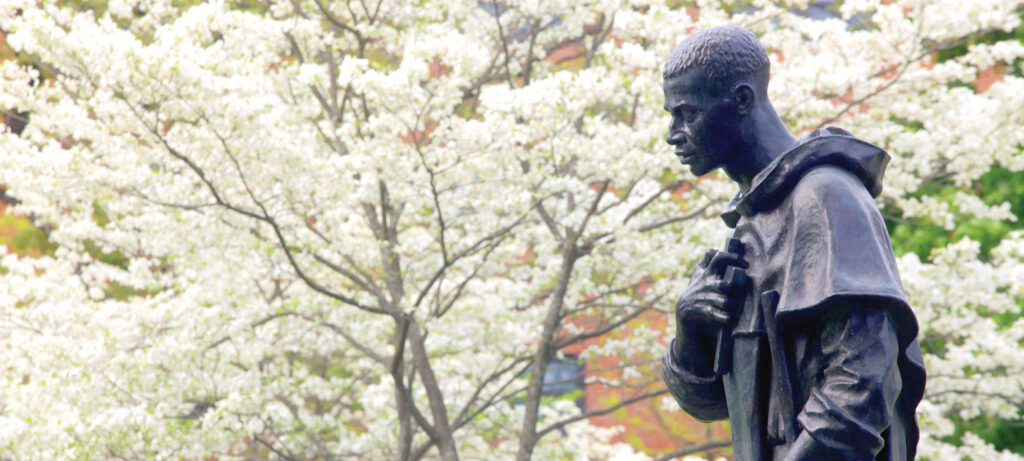
There are two statues of St. Martin de Porres on the Providence College campus. One seven foot bronze statue (pictured) is located in front of Martin Hall. A second smaller bronze stands in the Rev. Thomas M. McGlynn, O.P. Sculpture Court at a koi pool on East Campus.
Father McGlynn was ordained a Dominican priest in 1932 and soon was sent to study sculpture in Rome. His artistic ability is evident in the number of his creations. His priestly ministry at different times moved him to direct an interracial center for poor African Americans in Chicago, to become an unofficial chaplain to prisoners in an Italian jail, and to work for death row inmates in a Louisiana prison. After a short stay at Providence College, he moved to Pietrasanta, Italy, to create a statue of Our Lady of Fatima, which is on the façade of the basilica there in Portugal. Father McGlynn interviewed Sister Lucy, one of the visionary children, to capture the authentic vision she saw of Our Lady.
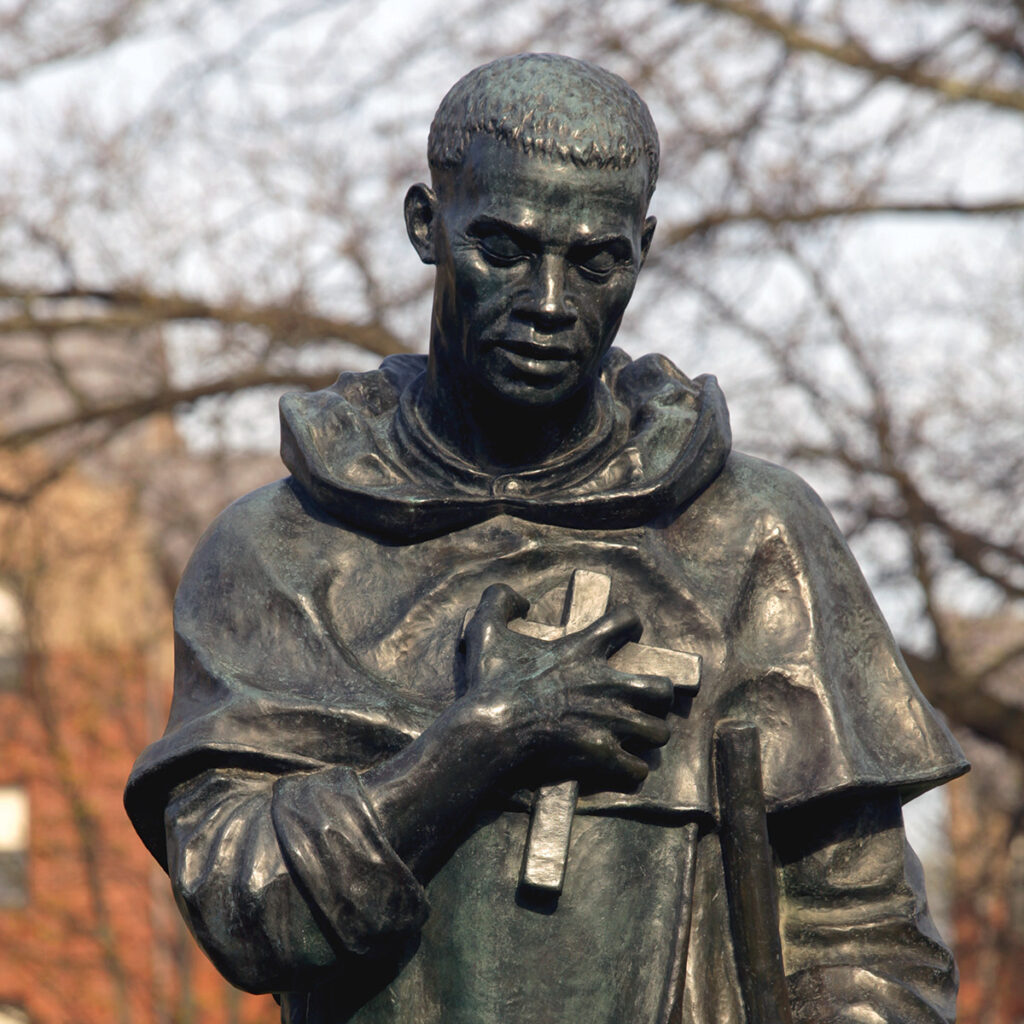
The figure of St. Martin de Porres at Providence College is the second casting of the figure. The saint is shown grasping a crucifix in his hand and a broom at his side. Father McGlynn had great devotion to St. Martin, his Dominican brother, and in his ministry tried to imitate Martin’s concern for peoples unjustly treated.
Reflection
To change this label, please fill in the field “Tab Label” on the right.
“Racism is a virus that quickly mutates and, instead of disappearing, goes into hiding, and lurks in waiting. Instances of racism continue to shame us, for they show that our supposed social progress is not as real or definitive as we think.” — Pope Francis
Martin de Porres was a Dominican brother born in Peru, the son of a Spanish noble and a mother who was a freed slave of African and Native descent. He experienced poverty, racial prejudice, and rejection growing up in Lima, the Peruvian capital. He entered the Dominican Order as a brother since a law forbade descendants of Africans and Native tribal people being ordained members of religious orders. As a brother, Martin ministered to the sick, the homeless, the marginalized.
The Dominican Martin was a man of prayer, devoted to the Eucharist and to the rosary. He was known as a miracle worker and was thought of as a saint even in his lifetime. Pope Saint John XXIII canonized him on May 6, 1962. His feast day is celebrated in the Catholic Church on November 6 and he is the patron of people of mixed race. Many consider him the patron saint for interracial justice.
Prayer
To change this label, please fill in the field “Tab Label” on the right.
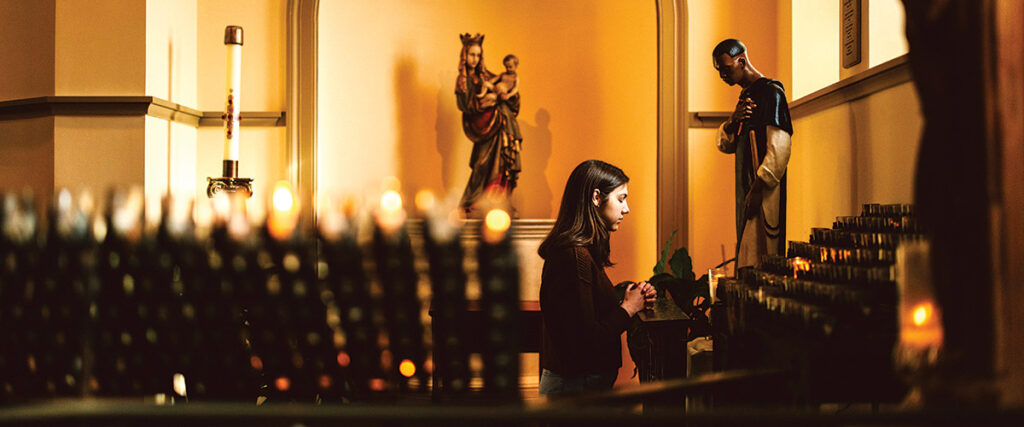
Lord Jesus Christ you called Saint Martin de Porres to be a witness to peace and justice by his life and ministry. May his prayers bring about an end to the sin of racism and ethnic hatred. Following his example will help all women and men of good will see each other as sisters and brothers created by God and saved through the death and resurrection of Jesus Christ. Amen.
5. War Memorial Grotto
About
To change this label, please fill in the field “Tab Label” on the right.
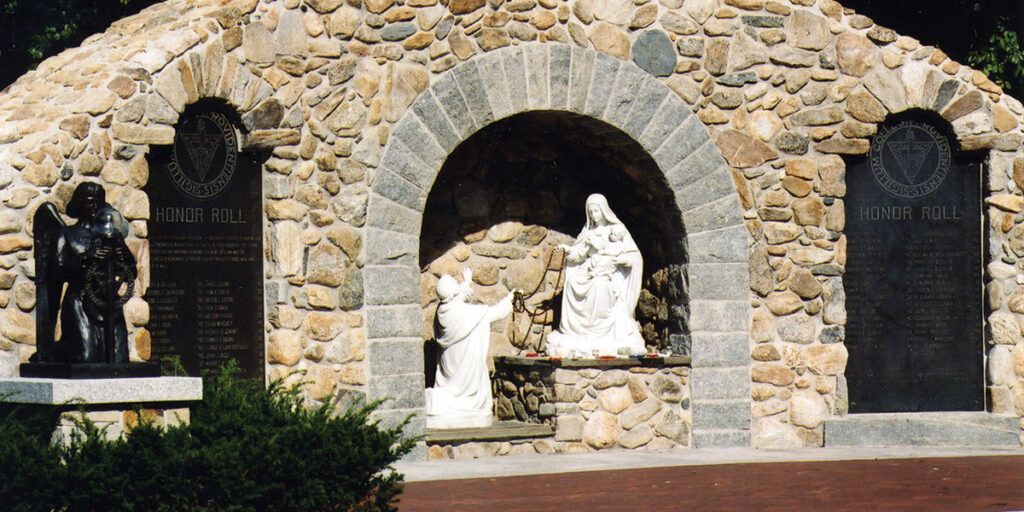
On May 9, 1948, the grotto in honor of Our Lady of the Rosary was dedicated to the memory of the 69 Providence College students or alumni who died in World War II. Over the years, Masses were celebrated there, especially during the months of October and May, in honor of the Blessed Mother. Rosary devotions were held in the evenings during those months. The grotto also became a place for significant college events such as the Baccalaureate Mass, Commencement Exercises, and Reserve Officers Training Corps (ROTC) commissioning. It also became a place for student sunbathing in good weather and athletic contests such as tag football. Given the growth in student population over the years it was decided that a larger worship space was needed. In early 2001, St. Dominic Chapel was dedicated in the area that had been the War Memorial Grotto. The signature “Rosary” group from the Grotto was moved to face the new chapel and the grotto’s Stations of the Cross were moved to the side of the new chapel.
Reflection
To change this label, please fill in the field “Tab Label” on the right.
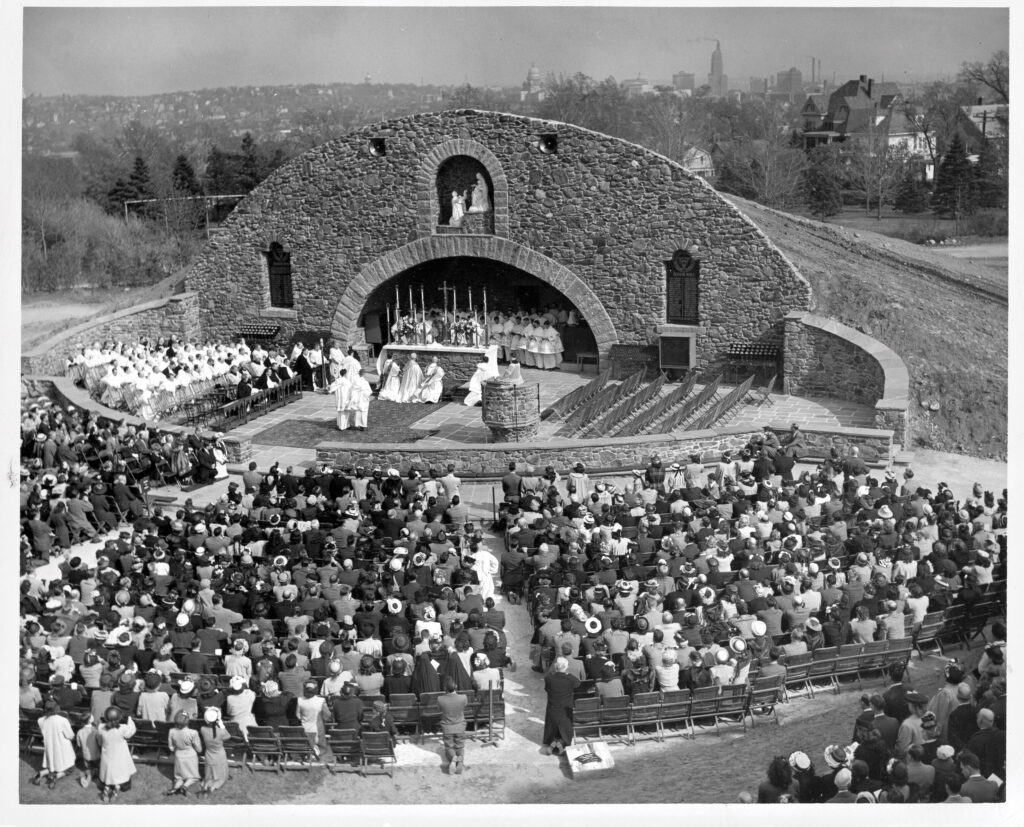
The original War Memorial Grotto was meant to honor those alumni who gave their lives in service to their country during World War II. Among other memorials on campus there are three near the president’s house to honor alumni who gave their lives during the Vietnam War. There is also a memorial in Saint Dominic’s chapel to the 10 women who died in the Aquinas Hall fire on December 13, in 1977. Such “shrines” are meant to remind all to be grateful for the people who have become part of their lives at Providence College, to pray for them, and to ask them to pray for us and not forget them.
Prayer
To change this label, please fill in the field “Tab Label” on the right.
The “Hail Mary” is a conversation.
Hail Mary, full of grace, the Lord is with you.
— The Words of the angel Gabriel at the Annunciation.
Blessed are you among women and blessed is the fruit of thy womb.
— The words of Elizabeth at the Visitation.
Holy Mary, Mother of God, pray for us sinners now and at the hour of our death. Amen.
— The words of the Church at prayer to Mary.
6. St. Dominic Chapel
About
To change this label, please fill in the field “Tab Label” on the right.
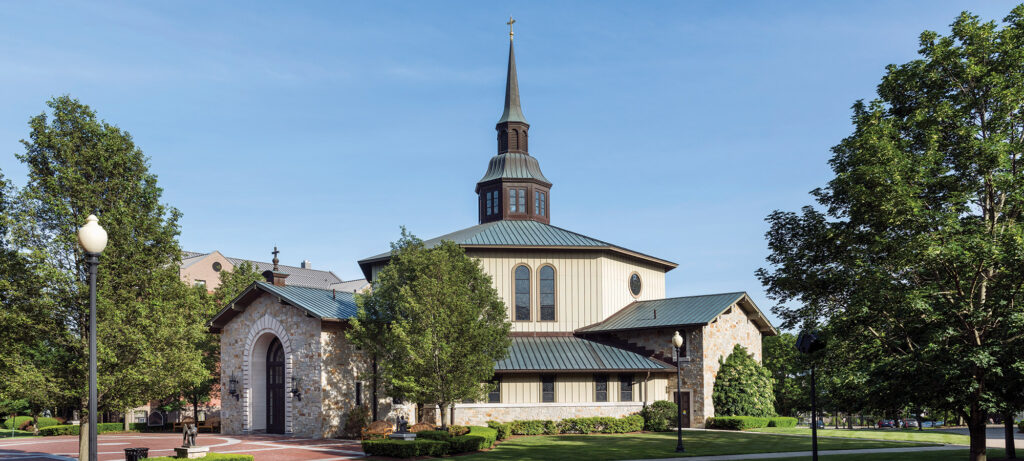
Beginning in 1939, the primary place for worship for Providence College students and visitors was the chapel in Aquinas Hall. Liturgies were celebrated there daily and on weekends. Presently that space has been converted to the Center for Catholic and Dominican Studies, to promote that mission of the College. In earlier days, Dominican friars prayed in a cloistered chapel on the fifth floor of Harkins Hall and a number of them lived on the fourth floor. As the student body grew, a new, larger worship space was needed and so St. Dominic Chapel was built, opening in 2001. The architect, Dennis Keefe, thought the chapel should “express both the permanence and the relevance of the gospel, should be traditional yet unmistakably of our own time, and should attract and challenge the students who worship there.” The chapel was built through the generous gift of Frank ‘40 and Charlotte Grangnani.
The chapel is octagonal in shape with open stone and wood interior space and high wooden ceilings. There are 45 stained glass windows, designed by the artist Sylvia Nicolas, ’01Hon., which show the history and mission of the Dominican Order. She also designed the central crucifix and Stations of the Cross. Portrayed in the windows is the life of Saint Dominic and other women and men saints such as the Peruvian Dominican brother Juan Macias; the African woman Sister Chicaba; St. Elizabeth Ann Seton, the North American founder of the Sisters of Charity; Bartolome de las Casas, the Spanish Dominican theologian of human rights; and Dorothy Day, the founder of the Catholic Worker Movement in the United States.
Reflection
To change this label, please fill in the field “Tab Label” on the right.
St. Dominic Chapel is a sacred space. The Blessed Sacrament is reserved there always and Eucharist is celebrated daily and on weekends. It is the liturgical heart of the campus and a central place for prayer. It is the site for other religious devotions, e.g. communal rosary, evening prayer, adoration of the Blessed Sacrament, Stations of the Cross during Lent, and the Sacrament of Reconciliation. A number of alumni have celebrated their weddings there as well. The campus ministry center is part of the chapel complex.
The architectural design fosters prayer as it is listening to God, being present to God, speaking with God, meditating or contemplating God. It is a place to give thanks to God, Father, Son, Holy Spirit, and to ask the risen Lord Jesus Christ for help, healing, guidance, comfort, and support for self and for others. St. Dominic Chapel is an island of peace in a busy, active academic world.
Prayer
To change this label, please fill in the field “Tab Label” on the right.
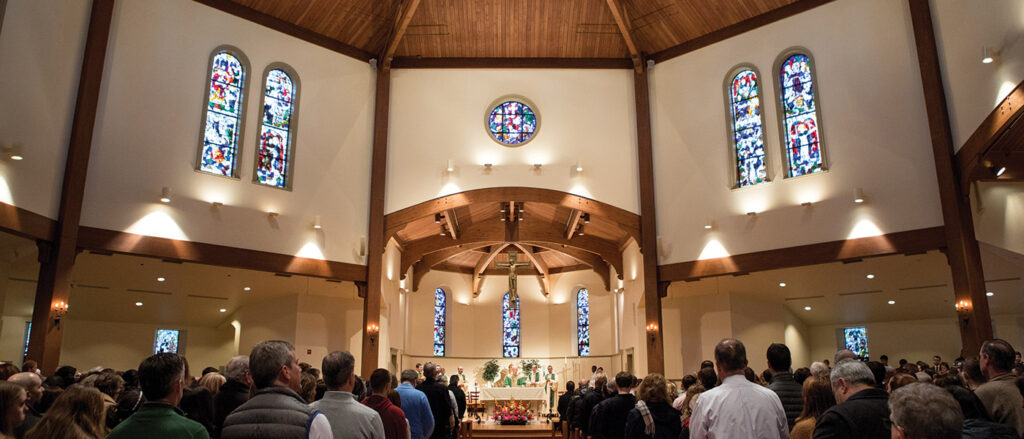
God, Father, we come to you in faith, grateful for all the blessings and gifts you have given us and those we love. Help us to grow in faith and witness to your great mercy and love for all women and men. Help us care for those we love, for each other, for those in any kind of need. Show us the way to follow the example of the saints who surround us in this holy place, St. Dominic chapel. We pray through the intercession of Mary, our Mother, St. Joseph, St. Dominic and all the community of Dominican saints. Amen.
7. St. Dominic Statue
About
To change this label, please fill in the field “Tab Label” on the right.
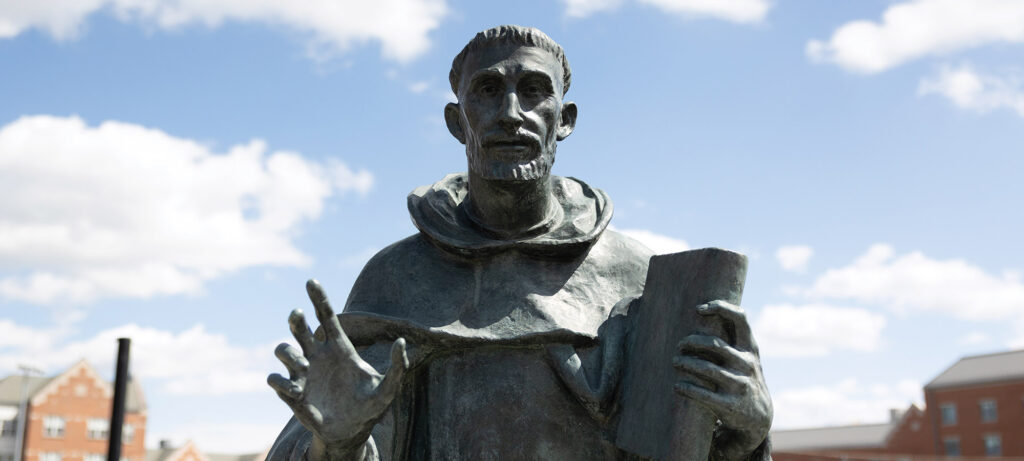
Among the Rev. Thomas M. McGlynn, O.P. ’77Hon. sculptures at Providence College is the fascinating bronze statue of St. Dominic Guzman. It captures a unique pose of the founder of the Order of Preachers. Father McGlynn represents the barefoot Dominic walking through thorns in Languedoc, France, on his preaching mission to the Albigensian heretics. Father McGlynn talked of this work of art: “Dominic, firm as his bronze, is moving forward, agile and serene through Languedoc, the world of his time, to praise, to bless, to preach, gripping the Gospel to his heart, with joy his answer to the malice of a guide who leads the way through “thorns …”
Dominic was Father McGlynn’s last major commission. It was done in 1974 for the church of Madonna dell’Arco, some eight miles from Naples, Italy, where a General Chapter of Dominicans was being held. The bronze statue is six feet tall. A second casting was made in 1978 and donated by an anonymous benefactor to the Dominican Province of St. Joseph which, in turn, gave it to Providence College. St. Dominic now stands on a prominent overlook near Guzman Hall, alongside the site of the former Huxley Avenue extension that ran through campus.
Reflection
To change this label, please fill in the field “Tab Label” on the right.
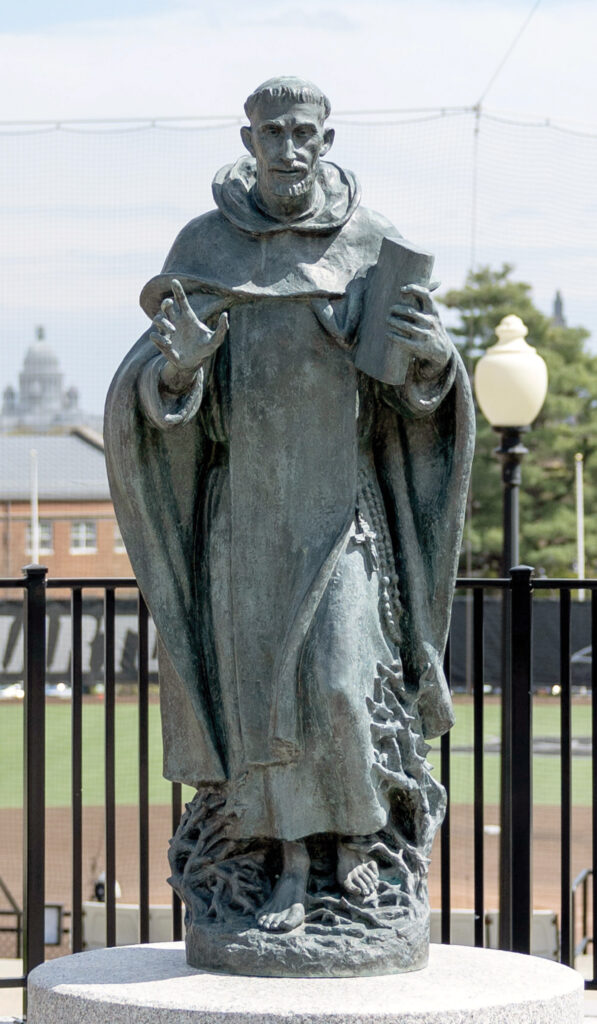
The young priest Dominic Guzman was chosen by God’s providence to leave security to become an itinerant apostle. He heard a call to preach God’s merciful love, forgiving love, accepting love to anyone who would listen. He surrendered to that call and soon attracted others to live and preach the Gospel with him. The Order of Preachers, the Dominicans, was born. Dominic was smart, energetic, imaginative, adaptable, and focused. He could see clearly with a love for and an understanding of other women and men. For him the risen Lord Jesus Christ was everything and he wanted to share that with the world. Dominic’s trust in God’s providence and his courage allowed him to risk change, to do new things, and to deal with opposition so as to be free to preach the gospel wherever and whenever. Following Dominic’s lead, his friars for more than 800 years have wed themselves to the task of evangelization. Everything in Dominican life is “action rooted in contemplation” of the mysteries of the revealed God, Father, Son, and Holy Spirit. Dominican life is not about security, comfort, convenience, or protection. Friars pray, study, live in community, and in the words of Pope Francis, practice a “synodal form of government built on fraternity” so that they can preach the gospel in whatever contemporary form their mission may take. Dominic’s friars embrace the theological perspective habitus theologicus, and continuously feed that habit through study and reflection no matter what their particular ministry.
Prayer
To change this label, please fill in the field “Tab Label” on the right.
To Our Holy Father Dominic
O wonderful hope which you gave to those who wept for you at the hour of your death, promising that after your departure you would be helpful to your brothers. Fulfill, Father, what you have said and help us by your prayers.
You who shined with so many miracles on the body of the sick, bring us the help of Christ, to heal our sick souls. Fulfill, Father, what you have said and help us by your prayers.
O God, who has enlightened your Church by the virtues and preaching of St. Dominic, grant that by his prayers we Friars may be energized to truly be apostles to the women and men of today, preaching with intelligence, care, respect, and conviction. Amen.
8. Labyrinth
About
To change this label, please fill in the field “Tab Label” on the right.
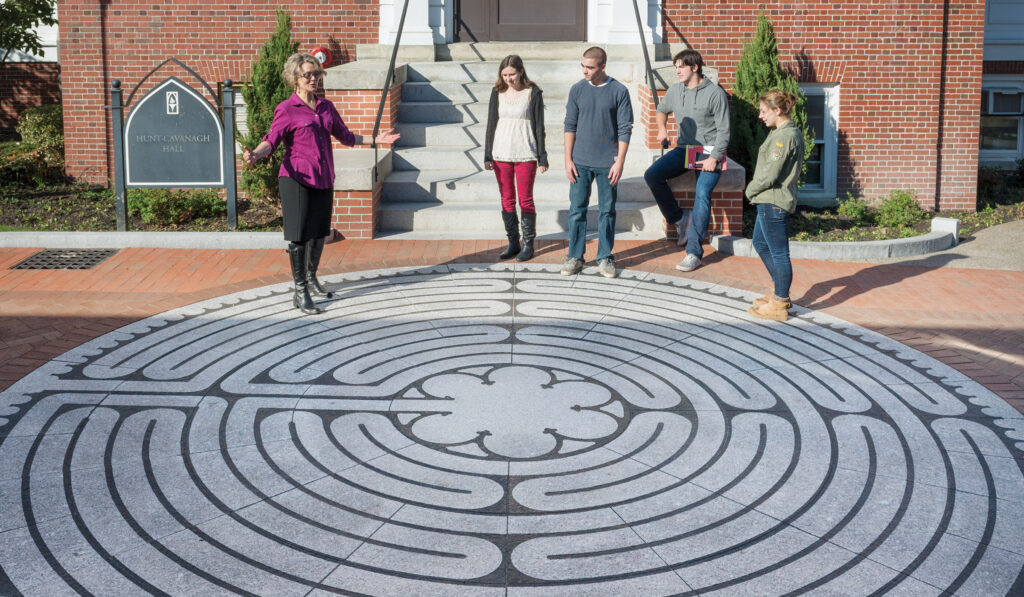
A pilgrimage is a religiously motivated journey to a sacred shrine or holy place. The medieval pilgrimage became a metaphor for the journey of the human person searching for salvation and eternal life with God in the next world while traveling through this world. A labyrinth in many Catholic churches in the Middle Ages often became a symbol of pilgrimage or repentance. Walking the labyrinth made it possible for someone to accomplish a spiritual journey in their local church. A pilgrim followed 11 winding circuits set inside four quadrants ending in a rosette center. When used for repentance, pilgrims often walked on their knees. The labyrinth at Providence College is a replica in miniature of the labyrinth on the floor of the Gothic cathedral at Chartres, near Paris, France, which was built in the year 1200.
Reflection
To change this label, please fill in the field “Tab Label” on the right.
This labyrinth in the arts district of campus hopes to connect Providence College to a long and rich tradition of sacred spaces and iconography. Sculpture, art, images, sacred places, memorials on campus are meant to deepen a sense of faith and foster a sense of shared community in the Providence College ethos and mission.
Prayer
To change this label, please fill in the field “Tab Label” on the right.
God, Our Father, we give thanks for the many blessings you offer all the members of the Providence College community. Grace each of us with a vision of truth and beauty and to share that with the diverse worlds we live in. Make us instruments of peace and mutual appreciation for every woman and man, your images. Amen.
9. The Dominican Cemetery
About
To change this label, please fill in the field “Tab Label” on the right.
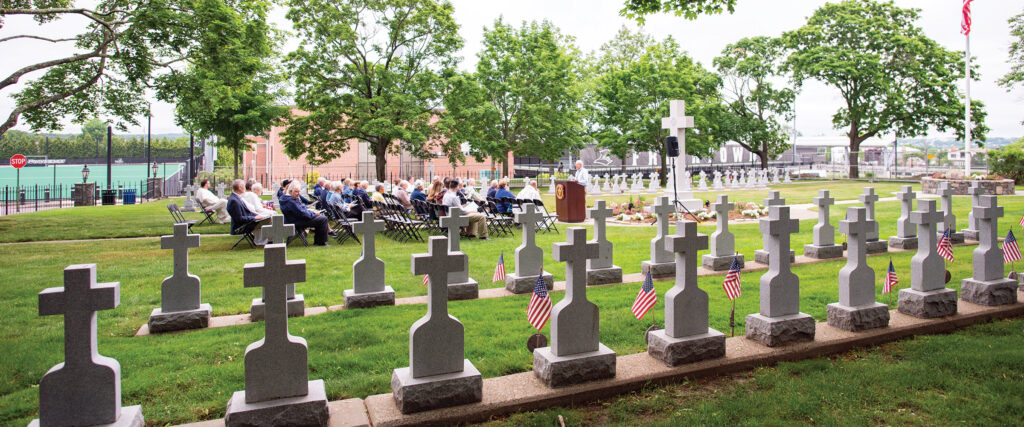
A plot of land on campus has been set aside as a cemetery for the Dominicans assigned to the community at Providence College. In the center is a large cross surrounded by a number of smaller crosses marking the graves of friars who have ministered at the College. Presently there are more than 115 such graves. One may wonder why a cemetery on a college campus? The Dominican cemetery points to the religious, Catholic faith that drives the mission of Providence College. The friars buried there deeply believed in the resurrection of Jesus Christ from the dead and the promise of resurrection for all women and men. It was that which moved them to live and serve the college community, to give their lives happily to that mission.
Reflection
To change this label, please fill in the field “Tab Label” on the right.
Dominican life is a call to preach the gospel of Jesus Christ. Friars are highly educated and serve with a theological vision of what it means to be a human person and human community. They take a vow of obedience to do this for life. They have done this for more than a century at Providence College. Hundreds of them have ministered at the College for a short or long time in a host of different capacities. Dominican preaching is based on prayer, study, simplicity in lifestyle, and living in community. The gospel of Jesus Christ shapes their lives and the labors. Their success in this mission differs due to personal talents, sometimes weaknesses or limits, historical events, and culture. The friars buried in the campus cemetery worked diligently, prayed faithfully, did their best and certainly died trying.
Prayer
To change this label, please fill in the field “Tab Label” on the right.
Eternal rest grant to them O Lord, may your light shine upon them. May all the souls of the faithful departed rest in peace.
10. Calabria Plaza
About
To change this label, please fill in the field “Tab Label” on the right.
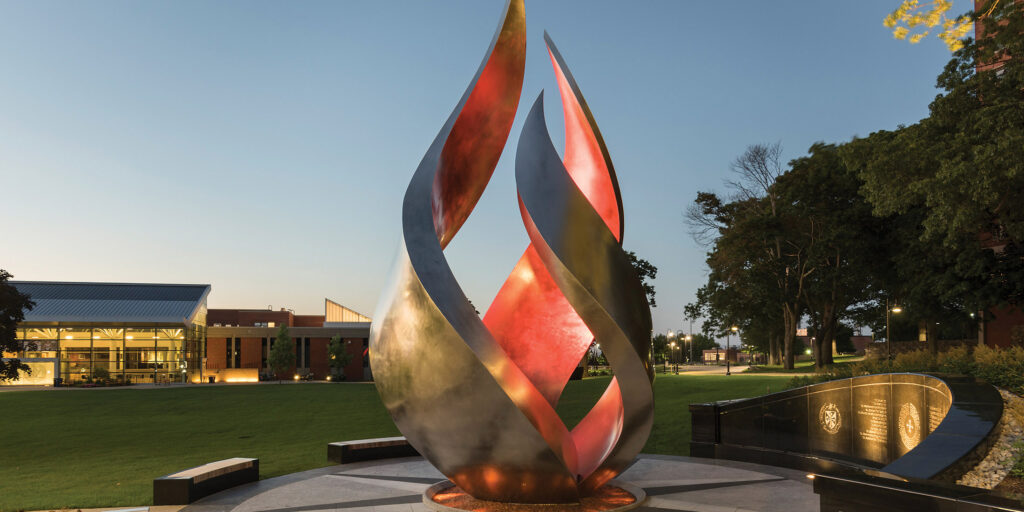
The stainless steel frame in the Calabria Plaza is a physical representation of the Providence College motto Veritas or Truth, symbolized by a torch. The plaza includes a black polished wall etched with the names of Dominican saints, the college alma mater and the seals of the Dominican Order and Providence College. The three steel tongues of flame represent the persons of the Blessed Trinity, Father, Son, and Holy Spirit. The plaza and flame are meant to be icons for light and truth, the Catholic and Dominican identity of Providence College.
Reflection
To change this label, please fill in the field “Tab Label” on the right.
Veritas, Latin for is the motto of the Dominican Order. The educational and formational enterprise which is the heart and soul of the Providence College experience is the quest for the understanding of, the witness to, truth. Truth is the work of reason and science. Truth is the gift of divine revelation. Women and men who graduate from Providence College, professors, and staff always look for, study, and defend truth. This quest is shaped by the search for truth, in the words of the Alma Mater inscribed on the Calabria Plaza wall: “Mother of Truth, We proudly pledge to thee, Undying love and steadfast loyalty….”
Prayer
To change this label, please fill in the field “Tab Label” on the right.
The Providence College Alma Mater
Mother of Truth, we proudly pledge to thee
Undying love and steadfast loyalty,
From thee we learned the wondrous work of God,
His goodness, grace and holy power;
Clear thou hast shown that pathways must be trod:
All fearless now we brave life’s hour!
Though failure frown, though kindly fortune smile,
Firm our advance, naught can us e’er beguile.
To honor bound, to love and virtue sworn,
Lift we our voices to full acclaim;
Our lives shall thee with noble deeds adorn;
Hail Providence! We praise thy name!





